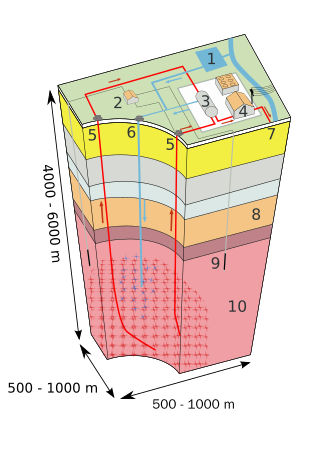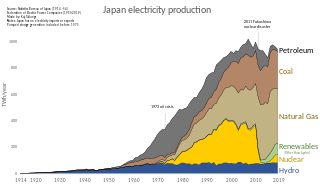Related Research Articles

Renewable energy is energy from renewable natural resources that are replenished on a human timescale. The most widely used renewable energy types are solar energy, wind power, and hydropower. Bioenergy and geothermal power are also significant in some countries. Some also consider nuclear power a renewable power source, although this is controversial. Renewable energy installations can be large or small and are suited for both urban and rural areas. Renewable energy is often deployed together with further electrification. This has several benefits: electricity can move heat and vehicles efficiently and is clean at the point of consumption. Variable renewable energy sources are those that have a fluctuating nature, such as wind power and solar power. In contrast, controllable renewable energy sources include dammed hydroelectricity, bioenergy, or geothermal power.

Geothermal energy is thermal energy extracted from the Earth's crust. It combines energy from the formation of the planet and from radioactive decay. Geothermal energy has been exploited as a source of heat and/or electric power for millennia.

POSCO is a South Korean steel manufacturer headquartered in Pohang, South Korea. It had an output of 42,000,000 metric tons of crude steel in 2015, making it the world's sixth-largest steelmaker by this measure. In 2010, it was the world's largest steel manufacturing company by market value. Also, in 2012, it was named as the world's 146th-largest corporation by the Fortune Global 500.
Induced seismicity is typically earthquakes and tremors that are caused by human activity that alters the stresses and strains on Earth's crust. Most induced seismicity is of a low magnitude. A few sites regularly have larger quakes, such as The Geysers geothermal plant in California which averaged two M4 events and 15 M3 events every year from 2004 to 2009. The Human-Induced Earthquake Database (HiQuake) documents all reported cases of induced seismicity proposed on scientific grounds and is the most complete compilation of its kind.

Japan is a major consumer of energy, ranking fifth in the world by primary energy use. Fossil fuels accounted for 88% of Japan's primary energy in 2019. Japan imports most of its energy due to scarce domestic resources. As of 2022, the country imports 97% of its oil and is the larger liquefied natural gas (LNG) importer globally.

Renewable energy commercialization involves the deployment of three generations of renewable energy technologies dating back more than 100 years. First-generation technologies, which are already mature and economically competitive, include biomass, hydroelectricity, geothermal power and heat. Second-generation technologies are market-ready and are being deployed at the present time; they include solar heating, photovoltaics, wind power, solar thermal power stations, and modern forms of bioenergy. Third-generation technologies require continued R&D efforts in order to make large contributions on a global scale and include advanced biomass gasification, hot-dry-rock geothermal power, and ocean energy. In 2019, nearly 75% of new installed electricity generation capacity used renewable energy and the International Energy Agency (IEA) has predicted that by 2025, renewable capacity will meet 35% of global power generation.
Nuclear power is a major power source in South Korea, providing 29% of the country's electricity. The total electrical generation capacity of the nuclear power plants of South Korea is 20.5 GWe from 23 reactors, equivalent to 22% of South Korea's total electrical generation capacity.

The Geysers is the world's largest geothermal field, containing a complex of 18 geothermal power plants, drawing steam from more than 350 wells, located in the Mayacamas Mountains approximately 72 miles (116 km) north of San Francisco, California.

An enhanced geothermal system (EGS) generates geothermal electricity without natural convective hydrothermal resources. Traditionally, geothermal power systems operated only where naturally occurring heat, water, and rock permeability are sufficient to allow energy extraction. However, most geothermal energy within reach of conventional techniques is in dry and impermeable rock. EGS technologies expand the availability of geothermal resources through stimulation methods, such as 'hydraulic stimulation'.

South Korea is a major energy importer, importing nearly all of its oil needs and ranking as the second-largest importer of liquefied natural gas in the world. Electricity generation in the country mainly comes from conventional thermal power, which accounts for more than two thirds of production, and from nuclear power.

The utility electricity sector in Bangladesh has one national grid operated by Power Grid Company of Bangladesh with an installed capacity of 25,700 MW as of June 2022. Bangladesh's energy sector is not up to the mark. However, per capita energy consumption in Bangladesh is considered higher than the production. Electricity was introduced to the country on 7 December 1901.

Russia is the fourth largest generator and consumer of electricity in the world. Its 440 power stations have a combined installed generation capacity of 220 GW.

The electric power industry in Japan covers the generation, transmission, distribution, and sale of electric energy in Japan. Japan consumed approximately 918 terawatt-hours (TWh) of electricity in 2014. Before the 2011 Fukushima Daiichi nuclear disaster, about a quarter of electricity in the country was generated by nuclear power. In the following years, most nuclear power plants have been on hold, being replaced mostly by coal and natural gas. Solar power is a growing source of electricity, and Japan has the third largest solar installed capacity with about 50 GW as of 2017. Japan's electricity production is characterized by a diverse energy mix, including nuclear, fossil fuels, renewable energy, and hydroelectric power.
Italy's total electricity consumption was 302.75 terawatt-hour (TWh) in 2020, of which 270.55 TWh (89.3%) was produced domestically and the remaining 10.7% was imported.
In 2017, the Kenya Nuclear Electrification Board (Kneb) estimated that a 1,000 MW nuclear plant could be operational by 2027 and cost Ksh500-600 billion, to be located near a large body of water, such as the Indian Ocean, Lake Victoria or Lake Turkana.
Energy in Serbia is dominated by fossil fuels, despite the public preference for renewable energy.

This article describes energy and electricity production, consumption, import and export in Kenya. Kenya's current effective installed electricity capacity is 2,651 megawatts (MW), with peak demand of 1,912 MW, as of November 2019. At that time, demand was rising at a calculated rate of 3.6 percent annually, given that peak demand was 1,770 MW, at the beginning of 2018. Electricity supply is mostly generated by renewable sources with the majority coming from geothermal power and hydroelectricity.

The 2017 Pohang earthquake, measuring magnitude 5.4 on the Richter magnitude scale, struck Heunghae, Pohang, North Gyeongsang Province, South Korea on November 15, 2017. It is tied with the 2016 Gyeongju earthquake as the country's strongest earthquake in modern history, and the most destructive ever recorded with "an estimated 300 billion won in damage."

Air pollution in South Korea is an increasing threat to people and the environment. The air pollution comes from many sources, both domestic and international. Many forms of pollution have increased in South Korea since its rapid industrialization, especially in Seoul and other cities. According to the U.S. National Aeronautics and Space Administration (NASA), Seoul is one of the world's cities with the worst air pollution. From 2009 and 2013, the city's mean PM10 were higher than in many of the largest metropolitan cities in the world such as: Los Angeles, Tokyo, Paris, and London. This has resulted in health and environmental problems. Koreans buy masks and air purifiers to breathe cleaner air, and are working to reduce the country's emissions.
The South Korean government plans to grow the renewable energy sector in the country. The country plans to use 20 percent renewable energy by 2030. The new plan will include a goal of 35 percent renewable energy by 2040. In the past, coal and nuclear power have been the pillars of South Korea's development. The country has long been one of the largest users of nuclear energy, but the liberal government, led by President Moon Jae In, decided to phase it out by 2057, fearing for its safety.
References
- ↑ Secretary, Executive Committee. "IEA Geothermal | Republic of Korea - International Energy Agency geothermal". IEA Geothermal. Retrieved 2024-06-01.
- ↑ "Seoul, South Korea Takes Action With Geothermal Energy". Smart Cities Connect. June 23, 2022.
- 1 2 "Geothermal plant responsible for powerful Pohang earthquake in 2017, says Gov't". The Korea Times . March 20, 2019.